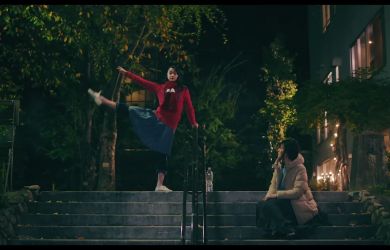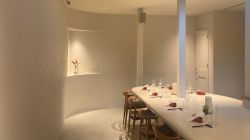
January 2, 2013
Anonymous Life
Strange new forms of life and art take shape at the ICC
By Metropolis
Originally published on metropolis.co.jp on January 2013

As the cultural facility of telecommunications giant NTT, the InterCommunication Center deals in art with a markedly technological bent. This means that not only are the exhibitions cutting edge, but the technology behind them is often “from the future” as well.
A case in point is the present show “Anonymous Life,” which brings together various pieces of art to explore the notion of new kinds of life arising from technology. It is these, as yet little understood, forms or extensions of life that give the show its name.
Some exhibits look at the way we shape our identity in superficial ways. For example, Tadasu Takamine’s video installation Ask for a Trade (1993) shows the conceptual artist using an American street market to completely change his identity and even perceived gender by repeatedly exchanging his clothes.
Clothes often have the power to invoke multiple personalities, but then this is only the low-tech end of the show. An extension of this theme is some photos by the French artist Orlan and an installation presenting the story of amputee athlete and model Aimee Mullins. Orlan’s work reveals her rather off-putting “experiments” on her sense of self through plastic surgery, while in the case of Mullins, we get a sense of how technology—in her case running blades and lifelike artificial legs—can fill in for human deficiencies in a more positive way.
From the “bionic woman” to a full-blown android is a relatively short step and it is one the exhibition takes with Hiroshi Ishiguro’s Beicho Android (2012), a carbon copy of Katsura Beicho, a well-known rakugo comedian/storyteller. Made by Hiroshi Ishiguro, the droid is capable of telling the same humorous stories as Beicho with all the facial expressions and hand movements of the original.
The show also includes Aevum (2009-12) by Go Watanabe. This is a large, animated, computer-generated entity that seems to straddle the boundaries between the real and virtual worlds, rather like the medieval concept of the title that refers to the mode of existence experienced by angels and saints in heaven, one intermediate between the timelessness of God and the temporal existence of the human world.
Also of interest is British-Japanese artist Sputniko whose cute, geeky art seems to be very attuned to the zeitgeist, and who has already made waves with her Menstruation Machine shown last year at MoMA in New York. Here she exhibits Crowbot Jenny (2011), a surreal pop video about a girl fixated on crow surveillance, and Field Mustard Heel, an installation built round a specially designed stiletto heel shoe that plants a seed of the yellow flower with every step.
The show doesn’t quite live up to the ambition of its concept, but it’s fun and interesting, nevertheless. Outside the ticket exhibition there is also the free exhibition “Open Space,” where a range of media artworks can be enjoyed. These include Indian artist Shilpa Gupta’s interactive Untitled (Shadow 2) (2006), which plays games with visitors’ silhouettes, and work by English video artists John Wood and Paul Harrison whose short movies are always thought-provoking and amusing.







